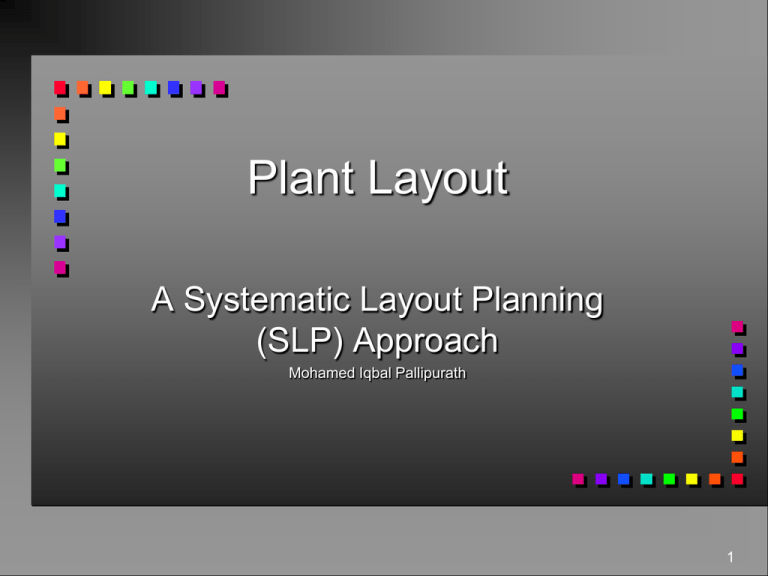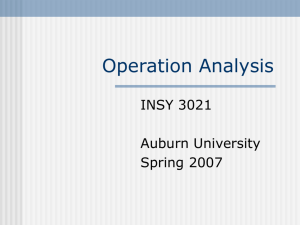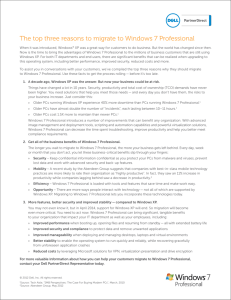New Design Control Req'mts
advertisement

Plant Layout A Systematic Layout Planning (SLP) Approach Mohamed Iqbal Pallipurath 1 THE NEED FOR GOOD FACILITIES PLANNING 1. Plant facilities influence operating costs and profits. 2. Planning allows facilities and its operations (OSHA, ISO 14001, etc.) to comply with laws and/or regulations. 3. Facilities are fixed investments involving high capital-cost expenditures. 4. Facilities are inflexible and long term commitments. 5. The planning, design and construction of facilities require long lead times. 6. Good planning helps to avoid disruptions in production and shipping or delivery. 2 THE NEED FOR GOOD FACILITIES PLANNING 7. The quality of facilities influences the attitudes of and the ability to attract suitable employees. 8. Industrial facilities must be planned to meet anticipated future requirements yet compete profitably today. 9. Facilities need to be planned for an appropriate degree of flexibility, expandability, versatility… 10. Good plans help management to take advantage of business opportunities that arise. 11. Good planning is an aid to obtain approval and financing monies. 12. Good planning reduces the high materials handling 3 $ resulting from “ad hoc” expansion of plant Economic Investment/Consequence ($) ECONOMIC IMPACT OF FACILITIES PLANNING Resources invested to provide the facilities Plan 20:1 Consequence on operations of facilities Design 2:1 Time Build & Install 1:10 DEFINING PERFORMANCE OBJECTIVES 1. 2. 3. 5 DEFINING PERFORMANCE OBJECTIVES 4. 5. 6. 6 TYPES OF MANUFACTURING LAYOUT CONFIGURATIONS I. Product Line Layout Product A B C 7 CHARACTERISTICS High volume production Special purpose machines and material handling equipment Throughput rates--high Work-in-process--low Setup/Run time ratio--low System is very inflexible Control is relatively simple 8 TYPES OF MANUFACTURING LAYOUT CONFIGURATIONS II. Flow Line Workcell T T T M M T M D D M D SG CG CG D T = turning D = drilling M = milling CG = center grinding SG = surface grinding SG GOAL: GAIN the advantages and efficiency of high volume production in a LOW/MEDIUM VOLUME (FLEXIBLE) ENVIRONMENT. GT-FLOW LINE WORKCELL CHARACTERISTICS Buffer 1 Workstation 1 Buffer 2 Workstation 1 Buffer m Workstation m 10 GT-FLOW LINE WORKCELL CHARACTERISTICS 1. Processes GT-based families of parts with frequent job change-over and small to medium batch sizes 2. Piece by piece (continuous flow) processing/movement 3. No backtracking in sequence flow, but machine skipping does occur 4. Accommodates flexible-type automation: CNC machines, robots for part handling 5. Finite buffers (resulting in machine blocking and starvation 11 TYPES OF MANUFACTURING LAYOUT CONFIGURATIONS III. Cellular Manufacturing (GT Workcell) CHARACTERISTICS 1. Dissimilar processes/machines 2. Similar parts (families) run in small to medium batch sizes 3. Mini - job shops 13 Process(Functional) Layout “Shaft” Sawing Turning S S S T T T S S S T T T Grinding T T T G G G G G G Heat Treating HT Gear Cut HT H T Milling M M M Boring GC GC B B GC GC B B Characteristics of Process Layouts Low Volume, High Variety Production with Random Routing (Spaghetti-Like Flow) General Purpose Machines- Machine setups are frequent and long Work-In-Process -- High Throughput Rates tend to be Low Material Handling -- High Operator Utilization -- Low? Throughput Times (Lead Time) -- High System is Very Flexible, produces many different types of parts: gears, shafts, pinions, housings, clamps, etc. 15 THE P-Q CURVE (High) Product A Product B Product C (Q) Volume or Quantity Q Etc. P (Low) (Low) (High) (P) Variety (High) Product Line G.T. Flowline Workcell Part Volume G.T. Manufacturing Workcell Functional (Job-Shop) (Low) (Low) Part Variety (High) Part Volume/Variety Relationships with Manufacturing Systems Configurations MATERIAL FLOW Importance of Material Flow Properly Planned Material Flow Effective Arrangement of Facilities Efficient Operations Profitability/Viability 18 Efficient Operations Involve: 1. 2. 3. 4. 5. 6. 7. Good utilization of floor space Reduced materials handling Appropriate equipment utilization Safety Less congestion Less wasted time/efforts Flexibility 19 MATERIAL FLOW KEY QUESTIONS 1. What is the most effective sequence of moving materials? Eliminate? Combine? Improve? Change Order? 2. What is the intensity and direction? Need to visualize the flow 20 FLOW OF MATERIAL vs P-Q MIX LAYOUT TYPE I I II III IV II Product Line Flow Line Workcell G.T. Workcell Functional III IV 21 TYPE I Casting Sheet Steel 4 Tons 0-4 Turn 3.3 Tons 0-5 10 Tons Drill 3 Tons Storage 0-1 Blank 9 Tons Turnings 0.7 Tons 0-2 Offal 1 Ton Form 9 Tons Turnings 0.3 Tons 0-3 Trim 7 Tons Bolts 10.5 Tons 0-6 Scrap 2 Tons Assemble/ Inspect Operation Process Chart showing intensity of material flow and the out-flow of chips and scrap. (Muther, SLP) TYPE II Operation Part or Product A B C Saw 1 1 1 Center 2 2 2 Turn 3 3 Heat Treat 4 Grind 5 Mill D 1 4 * 2 3 4 5 3 5 4 Multi-Product Process Chart *Shows problem flow to be resolved by design engineering and manufacturing engineering TYPE III Parts Machines 5 8 7 12 13 1 10 2 11 14 3 15 4 9 6 4 1 6 Exceptions 8 3 9 2 14 12 5 7 13 11 10 Part-Machine Matrix of Production Flow Analysis Turn 1 Hob 2 Slot Broach Heat Treat Drill Inspect Wash Mill Store FROM Hob TO Turn TYPE IV 1 2 3 4 5 6 7 8 9 10 = 3 26 - = 3 6 1 5 1 160 232 2 631 684 7 5 262 576 Slot 3 - - = Broach 4 - - - Heat Treat 5 - 1 2 1 20 - - - - - - - - - - - 10 - - = - - - - 5 576 = 3 910 - - - - =- 9 752 - - Inspect 7 - - - - - - - - 1 8 1 12 22 - 1 1 7 414 - 5 - - 6 8 - - - Drill Wash - - 12 3 12 - - Mill 9 - - - - - - - - = - Store 10 - - - - - - - - - = TOTALS FROM-TO CHART Number of Parts x y Number of Pieces TOTALS Activity Pair (Route) 8-13 1-3 3-4 8-15 3-12 11-15 10-13 3-7 7-15 1-14 4-12 4-9 4-15 1-7 2-3 11-15 3-5 1-4 1-12 2-8 11-9 Seq. No. 1 2 3 4 5 6 7 8 9 10 11 12 13 14 15 16 17 18 19 20 21 500 1000 1500 2000 2500 3000 3500 4000 4500 FLOW - OF - MATERIAL INTENSITY RANK THE FLOWS A E A: E: I: O: U: KEY Absolutely Necessary Especially Important Important Ordinary Unimportant I O U NON-FLOW (CLOSENESS) RELATIONSHIPS Flow based on routings is not the sole basis for layout arrangements. Adapted from Muther 27 NON-FLOW (CLOSENESS) RELATIONSHIPS Other Factors Supporting Services Tool Room (not routed) Rest Areas Central Coolant Tanks Shop Superintendent’s Office Adapted from Muther 28 NON-FLOW (CLOSENESS) RELATIONSHIPS Other Factors Separation of Areas Welding away from assembly Dirty Dangerous Separate Delicate High Pop Outside Doors / Separate / N/C Adapted from Muther 29 NON-FLOW (CLOSENESS) RELATIONSHIPS In some cases, flow is simply not important No Significant Flow Service, Repair, Tool Room Jewelry (one load per week) Adapted from Muther 30 1 2 3 4 5 6 Punch Press Auxiliary Punch Press Drilling Grinding General Fabrication 1 I 1 D 2 I 2 U U Wet Tumble 2 U U U 8 9 10 Special Production Raw Material Storage In-Process Storage I 2 E 2 Shop Toilet 12 Shop Office and Tool Room I 2 I 2 U U Assembly 11 U U U U I 2 U I 2 O 2 U E 2 U 6 U 7 8 I 2 A 2 O O 2 A 2 I 3 2 O 2 O 3 U U U U U O 3 O 4 5 U U E 2 U 4 U U 7 RELATIONSHIP CHART 3 O 2 O 2 U E O 3 U 5 I 4 E 2 O 3 O 4 9 I 10 2 O 11 U 3 I 12 13 O 4 14 O 4 15 4 X 6 U This block shows relation between “1” and “3” 1 U 2 3 13 14 15 Importance of Relationship (top) Adapted from Muther Reasons in Code (bottom) RELATIONSHIP CHART Codes Code “Closeness” Rating CLOSENESS Value A Absolutely Necessary 4 E Especially Important 3 I Important 2 O Ordinary Closeness OK 1 U Unimportant 0 X Undesirable -1 32 RELATIONSHIP CHART Value Reasons behind the “Closeness” Value 1 Equip. used by same persons 2 Movement of material 3 Movement of personnel 4 Supervision and/or support 5 Require same utilities 6 Noise and dirt 7 8 9 Adapted from Muther REASON RELATIONSHIP DIAGRAMS Conventions for diagramming activity relationships Vowel Letter No. Value No. of Lines Closeness Rating Color Code A 4 Absolutely Necessary Red** E 3 Especially Important Orange Yellow** I 2 Important Green** O 1 Ordinary Blue** U 0 Unimportant Uncolored** X -1 Not Desirable Brown** XX -2, -3, -4, ? Extremely Undesirable Black PROCEDURE/EXERCISE Dept. No. Sq. Feet Dept. Desc. 1 5,000 Parts Storage 2 10,000 Ship/Receiving 3 2,500 Welding 4 2,500 Testing 5 7,500 Machining 6 5,000 Assembly 7 2,500 Paint E U O U U X I I I U E I X A O U U X I U A Figure 1: Relationship Chart 35 PROCEDURE/EXERCISE TO FROM 1 2 3 4 5 1 2 50 170 40 80 4 50 6 7 7 170 3 5 6 50 20 20 120 20 120 120 Figure 2: From-To Chart (in Loads per Weeks) 36 1 Determine Total Flow TO FROM 1 1 2 3 4 5 2 3 4 5 50 6 7 170 170 90 80 120 50 20 140 120 20 6 7 37 2 Rank the Flows 200 180 140 120 100 80 60 3-7 3-6 1-2 3-5 2-5 4-7 2-7 4-6 2-3 20 5-7 40 1-6 Total Flow 160 0 0 1 2 3 4 5 6 7 8 9 10 11 38 3 Combine Flow & Non-Flow Relationships Activity Pairs 1-2 1-3 1-4 1-5 1-6 1-7 2-3 2-4 2-5 2-6 2-7 3-4 3-5 3-6 3-7 4-5 4-6 4-7 5-6 5-7 6-7 Non Flow: Flow 1 to 1 Ratio 3 0 0 2 3 0 1 0 2 2 0 -2 0 -2 -2 0 4 2 1 0 4 1 0 0 0 4 0 4 0 1 0 3 0 2 1 0 0 3 3 0 0 0 Combined Total Points 4 0 0 2 7 0 5 0 4 2 3 -2 2 -1 -2 0 7 5 1 0 4 39 4 Rank the Combined Points 10 9 7 6 5 4 3 5-6 2-6 1-5 2-7 6-7 2-5 1-2 4-7 2-3 4-6 1 3-5 2 1-6 0 0 1 2 3 4 5 6 7 8 9 10 11 12 3-6 3-4 3-7 Total Points 8 Activity Pairs 40 5 Develop Combined Relationship Chart (Flow and Non-Flow) 1 5,000 Parts Storage 2 10,000 Ship/Receiving 3 2,500 Welding 4 2,500 Testing 5 7,500 Machining 6 5,000 Assembly 7 2,500 Paint I E O XX I O A O X A I XX E I 41 6 Develop Relationship Diagram i Place “A” Relationship Values on Grid ii Add the “E” Relationship Values and Adjust Diagram to Minimize Distance X Flow Value iii Place “A” Relationship Values on Grid 42 6. Relationship Diagram A E I O U X XX + + + + + + + + + + + +4 +6 +1 + + +7 +2 +3 + + + +5 + + 7. Measures of Effectiveness Min Z = S S L ij i j Dij L ij = Load between departments i & j, often measured by the value of the Vowel Letter. A = 4, E = 3, I = 2, O = 1, U = 0, X = -1 Dij = Distance between departments i & j (move only at Right angles) *Many Variations of this Concept 8. Space Relationship Diagrams 9. Layouts 7. Diagram Score: Department Pair Lij Dij Zij 1-2 1-3 1-4 1-5 1-6 1-7 2-3 2-4 2-5 2-6 2-7 3-4 3-5 3-6 3-7 4-5 4-6 4-7 5-6 5-7 6-7 2 0 0 1 4 0 3 0 2 1 2 -1 1 -1 -1 0 4 3 0 0 0 2 0 2 3 1 3 1 2 1 1 1 3 2 2 2 3 1 1 2 2 2 4 0 0 3 4 0 3 0 2 1 2 -3 2 -2 -2 0 4 3 0 0 0 21 45 Types of Layouts (Q) Number of pieces/part# Product CM Job-Shop (process) Number of Part Numbers (P) 46 PRODUCT LAYOUT Product Layout: Continuous Flow Production System Definition: Layout is dictated by the product. (P) Suited to manufacturing processes with single output Equipment arrangement operation sequence High production (volume) items and stable demand, similar products: 47 PRODUCT LAYOUT Materials move by units in a product line, not by lots. *? UNIT 1. 2. 3. demand Operations performed at various workstations *The Output is determined by the slowest operation * \ TASK is to BALANCE the workstations in terms of the work done (time) and satisfy the required output. 48 PRODUCT LAYOUT Two Types of Problems: Fabrication Lines Required Information: (R) Sequence of operations or job elements (T) Time required for each operation or independent element Assembly Lines Output required (Q) 49 EXAMPLE Design a fabrication line to manufacturing a product with the following 7 operations. Initially assume: No scrap losses 100% eff. & 480 min/day 1000 units required per day 50 EXAMPLE Specifically determine A) The number of machines required at each workstation, and B) The % of idle time for the following operations: Opn # Operation 1 2 3 4 5 6 7 Saw Center Turn (RGH) Heat Treat Fin Turn Grind Mill 51 OUTPUT REQ’D: 1000 UNITS/DAY Opn A Std Time B Cont. Output C D=A*B*C Machines Theoretical Req’d Prod. Time 1 2 3 4 5 6 7 Totals 1.20 min 0.80 min 1.00 min 2.40 min 0.40 min 3.00 min 1.20 min 10.0 min 400 pcs 600 pcs 480 pcs 200 pcs 1200 pcs 160 pcs 400 pcs per machine 3 2 3 5 1 7 3 Idle = 11520-10000 11520 1440 min 960 min 1440 min 2400 min 480 min 3360 min 1440 min 11,520 min Std Time (Output) Actual Prod. Time 1200 min 800 min 1000 min 2400 min 400 min 3000 min 1200 min 10,000 min 13.2% 52 OUTPUT REQ’D: 1200 UNITS/DAY Opn Number of Stations Theo. Time 1 2 3 4 5 6 7 3 2 3 6 (+1) 1 8 (+1) 3 1440 960 1440 2880 480 3840 1440 12,480 Idle = 12480-12000 12480 Act. Time = = > = = > = 1440 960 1200 2880 480 3600 1440 12,000 3.8% 53 OUTPUT REQ’D: 800 UNITS/DAY Opn Number of Stations Theo. Time 1 2 3 4 5 6 7 2 (-1) 2 2 (-1) 4 (-1) 1 5 (-2) 2 (-1) 960 960 960 1920 480 2400 960 8640 Idle = 640 8640 Act. Time = = = = > = = 960 640 800 1920 320 2400 960 8000 7.4% 54 SUMMARY Output Rate Total Number Of Machines % Idle 800 900 1000 1100 1200 1300 1400 1500 18 22 24 7.4 14.7 13.2 26 3.8 CONCLUSIONS: 55 INVENTORIES Now how does one handle the idle time which occurs? *i.e., complete balance not possible. Ans. Work in-process inventories are used to “decouple” operations. Slack for machine breakdowns Stat 1 Inven Stat 2 Inven Stat 3 56 SYSTEM UTILIZATION LEVELS Production Level (pcs/hr) Stat No. Hourly Capacity per “Machine” 40 55 60 2) 1 55 73% 100% 2) 2 3 4 40 85 105 100% 47% 38% 2) 55% 2) 69% 65% 52% 80 73% 2) 75% 71% 57% 1005 94% 76% 2) 5 60 Avg. Util. Add’l Mach. New Util. 67% 65% 2 54% 92% 75% 1 64% 100% 70% 5 61% 67% 81% 2 72% 57 How to Handle Scrap Station 1 Station 2 Station 3 ? 150 pcs/hr Operation Std. Time (min/part) Scrap% Efficiency% 1 0.3 5 0.9 2 0.5 3 1.05 3 1.1 4 1.00 What inputs are required at each station? How many machines are required at each station? 58 TERMS Inputn = Outputn (1.00-Scrapn) Efficiency = Std. Time Actual Time X 100% 59 Station #3 Input Input = 150 150 (1-.04) = 156.25 = 157 Std Time = 1.1 min/pc. 54.5 pcs/std. hr. x 1.00 Eff. 54.5 54 pc/hr./machine 2.91 157/54 3 machines 60 Station #2 2 Input = 157 = Std Time = .5 min/pc. 120 pcs/std. hr. x 1.05 Eff. 126 pcs/hr./machine 162/126 = 1.28 2 61 Station #1 Input = = Std Time = .3 min/pc. 200 pcs/std. hr. x .90 Eff. 180 pcs/hr./machine 171/180 = .95 1 62 Operation Production time (min) per Mc Mc Theoretical time (min) Idle time (min) 1 Actual production rate (part/hr) per Mc 180 57 1 60 3 2 126 77.14 2 120 42.86 3 54 174.44 3 180 5.56 360 51.42 Total 308.58 Idle = (360 - 308.58)/360 = 0.143 Utilization = 1 - 0.143 = 0.857 63 Final Layout 3 2 1 162 157 171 150 64 Class Problem A circuit line consists of four processes: A: chip production, B: assembly, C: test, and D: package. Three chips go into every assembly. The production and scrap rates are as follows: Process Production Rate (Pcs/hr) A B C D 200 60 55 70 Scrap (%) 15 10 5 0 What is the output rate of this line? 65






